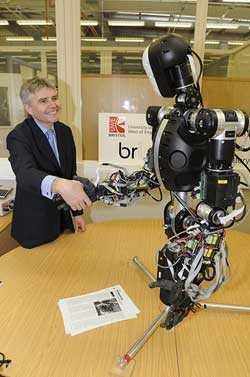Robotics: Gesturing for control

Copyright : DIUSGOVUK<br>
Many works of science fiction have imagined robots that could interact directly with people to provide entertainment, services or even health care. Robotics is now at a stage where some of these ideas can be realized, but it remains difficult to make robots easy to operate.
One option is to train robots to recognize and respond to human gestures. In practice, however, this is difficult because a simple gesture such as waving a hand may appear very different between different people. Designers must develop intelligent computer algorithms that can be ‘trained’ to identify general patterns of motion and relate them correctly to individual commands.
Now, Rui Yan and co-workers at the A*STAR Institute for Infocomm Research in Singapore have adapted a cognitive memory model called a localist attractor network (LAN) to develop a new system that recognize gestures quickly and accurately, and requires very little training.
“Since many social robots will be operated by non-expert users, it is essential for them to be equipped with natural interfaces for interaction with humans,” says Yan. “Gestures are an obvious, natural means of human communication. Our LAN gesture recognition system only requires a small amount of training data, and avoids tedious training processes.”
Yan and co-workers tested their software by integrating it with ShapeTape, a special jacket that uses fibre optics and inertial sensors to monitor the bending and twisting of hands and arms. They programmed the ShapeTape to provide data 80 times per second on the three-dimensional orientation of shoulders, elbows and wrists, and applied velocity thresholds to detect when gestures were starting.
In tests, five different users wore the ShapeTape jacket and used it to control a virtual robot through simple arm motions that represented commands such as forward, backwards, faster or slower. The researchers found that 99.15% of gestures were correctly translated by their system. It is also easy to add new commands, by demonstrating a new control gesture just a few times.
The next step in improving the gesture recognition system is to allow humans to control robots without the need to wear any special devices. Yan and co-workers are tackling this problem by replacing the ShapeTape jacket with motion-sensitive cameras.
“Currently we are building a new gesture recognition system by incorporating our method with a Microsoft Kinect camera,” says Yan. “We will implement the proposed system on an autonomous robot to test its usability in the context of a realistic service task, such as cleaning!”
The A*STAR-affiliated researchers contributing to this research are from the Institute for Infocomm Research
References:
Yan, R., Tee, K.P., Chua, Y., Li, H. & Tang, H. Gesture recognition based on localist attractor networks with application to robot control. IEEE Computational Intelligence Magazine 7, 64–74 (2012). (link to original article below)
Media Contact
All latest news from the category: Information Technology
Here you can find a summary of innovations in the fields of information and data processing and up-to-date developments on IT equipment and hardware.
This area covers topics such as IT services, IT architectures, IT management and telecommunications.
Newest articles

Superradiant atoms could push the boundaries of how precisely time can be measured
Superradiant atoms can help us measure time more precisely than ever. In a new study, researchers from the University of Copenhagen present a new method for measuring the time interval,…

Ion thermoelectric conversion devices for near room temperature
The electrode sheet of the thermoelectric device consists of ionic hydrogel, which is sandwiched between the electrodes to form, and the Prussian blue on the electrode undergoes a redox reaction…

Zap Energy achieves 37-million-degree temperatures in a compact device
New publication reports record electron temperatures for a small-scale, sheared-flow-stabilized Z-pinch fusion device. In the nine decades since humans first produced fusion reactions, only a few fusion technologies have demonstrated…





















